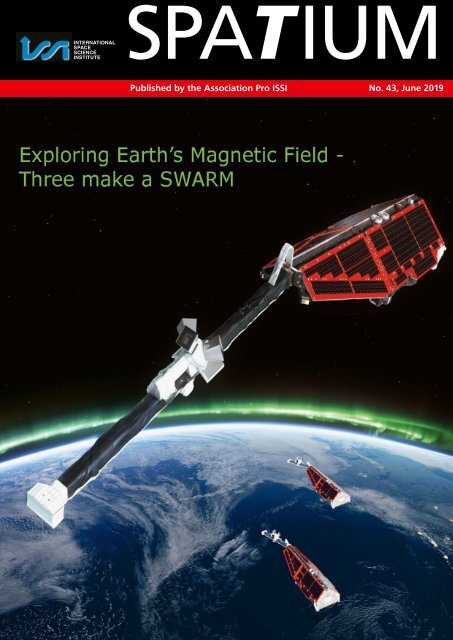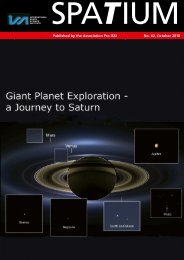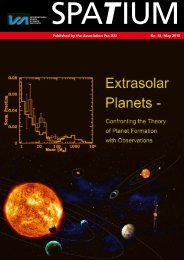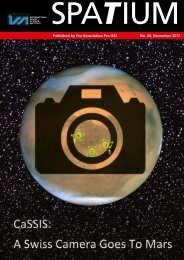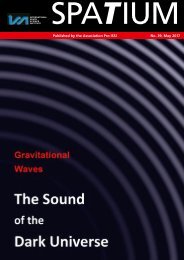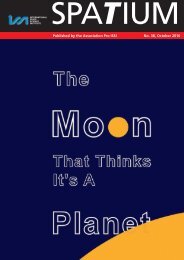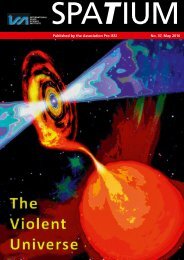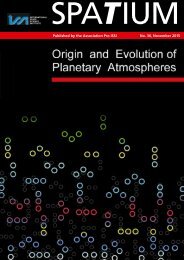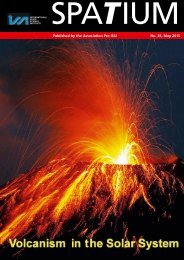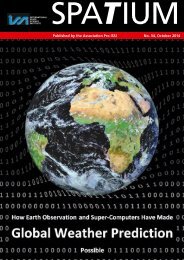Exploring Earth's Magnetic Field - Three make a SWARM
Pro ISSI talk by Nils Olsen SPATIUM Volume 43 published by the Association Pro ISSI (June 2019)
Pro ISSI talk by Nils Olsen
SPATIUM Volume 43 published by the Association Pro ISSI (June 2019)
- No tags were found...
Create successful ePaper yourself
Turn your PDF publications into a flip-book with our unique Google optimized e-Paper software.
INTERNATIONAL<br />
SPACE<br />
SCIENCE<br />
INSTITUTE<br />
SPATIUM<br />
Published by the Association Pro ISSI No. 43, June 2019
Editorial<br />
Even if you are neither a migrating<br />
bird nor a seafarer nor any kind of<br />
navigator you might have at least<br />
wondered how the majority of<br />
these species are able to follow their<br />
paths and reach their far-away<br />
destinations on our planet. Concerning<br />
bird migration – this<br />
phenomenon employs a variety of<br />
senses, using, for example, landmarks<br />
and the Sun as orientation.<br />
However, a large part of the orientation<br />
guidance can be ascribed to<br />
the magnetic field of the Earth.<br />
Not only birds, but also various<br />
other animals use magnetoreception,<br />
the ability to detect magnetic<br />
fields, for orientation. How exactly<br />
this works, is not quite clear yet. It<br />
is hypothesised that proteins harbouring<br />
magnetically sensitive<br />
radical pairs (“magnetic molecules”)<br />
are responsible. Iron-containing<br />
minerals could also be<br />
involved, which have, for example,<br />
been detected in proteins found in<br />
pigeon beaks.<br />
If, however, you lack a significant<br />
amount of magnetically sensitive<br />
proteins and do not enjoy looking<br />
at a compass and map, and prefer<br />
navigation with electronic devices<br />
like phones and handheld computers,<br />
you should still be aware that<br />
the smartphone also commonly relies<br />
on a model of the geomagnetic<br />
field to determine your heading.<br />
There are many more life-sustaining<br />
features connected with the<br />
magnetic field of the Earth, but in<br />
particular its navigation support is<br />
gratefully acknowledged by the<br />
biased editor.<br />
In the preceding issues of Spatium<br />
we studied the puzzles of fellow<br />
Solar System planets such as Jupiter<br />
and Saturn, their structure and<br />
cores – it is time to wonder about<br />
the home station again … Earth<br />
still holds more than enough secrets<br />
for us to unravel. Some of<br />
them can be well addressed from<br />
space, and the magnetic field of our<br />
planet belongs to those.<br />
In March 2019, Prof. Nils Olsen<br />
from the Technical University of<br />
Denmark gave an excellent presentation<br />
on the geomagnetic field<br />
and its study in the pro ISSI lecture<br />
series. In this Spatium, we thus take<br />
the opportunity to introduce this<br />
fascinating topic.<br />
Anuschka Pauluhn<br />
Mönthal, June 2019<br />
Impressum<br />
ISSN 2297–5888 (Print)<br />
ISSN 2297–590X (Online)<br />
Spatium<br />
Published by the<br />
Association Pro ISSI<br />
Association Pro ISSI<br />
Hallerstrasse 6, CH-3012 Bern<br />
Phone +41 (0)31 631 48 96<br />
see<br />
www.issibern.ch/pro-issi.html<br />
for the whole Spatium series<br />
President<br />
Prof. Adrian Jäggi,<br />
University of Bern<br />
Layout and Publisher<br />
Dr. Anuschka Pauluhn<br />
CH-5237 Mönthal<br />
Printing<br />
Stämpf li AG<br />
CH-3001 Bern<br />
left: Nautical Chart of Mustique Island, Grenadines, Caribbean. On the right side<br />
the compass rose is shown referencing the difference of compass reading and true<br />
geographic north (declination). Credit: US National Geospatial-Intelligence Agency.<br />
right: Heading on a sailing tour from Tromsø to Svalbard.<br />
Title Caption<br />
Swarm over the Earth.<br />
Artist’s impression based on the true<br />
design of the spacecraft.<br />
Credit: ESA/AOES Medialab.<br />
SPATIUM 43 2
<strong>Exploring</strong> Earth’s magnetic field –<br />
<strong>Three</strong> <strong>make</strong> a Swarm 1<br />
Nils Olsen, DTU Space – Technical University of Denmark and Anuschka Pauluhn, PSI Villigen<br />
Introduction<br />
It is amazing how many important<br />
aspects of great impact in our<br />
every day life are still largely enigmatic<br />
to us. The Earth’s magnetic<br />
field is a good example – it belongs<br />
to the most mysterious aspects of<br />
our habitat. Indeed, the electromagnetic<br />
field in and around Earth<br />
generates complex forces that have<br />
innumerable effects on our daily<br />
environment and life.<br />
The geomagnetic field provides a<br />
huge shield that protects us from<br />
harmful solar charged particles and<br />
cosmic rays. Without this protection,<br />
life in its current form would<br />
not exist. Although it might not<br />
appear so at first glance, the Earth’s<br />
magnetic field is permanently<br />
changing: the magnetic north pole<br />
wanders – currently several tens of<br />
kilometres per year – and every few<br />
hundred thousand years the polarity<br />
of the Earth’s magnetic field<br />
flips. The field strength is constantly<br />
changing too – at present<br />
significantly weakening. Over the<br />
last 100 years, the dipole part alone<br />
has decreased by 7 %. However, in<br />
certain areas on Earth, for instance<br />
in the Southern Atlantic, the weakening<br />
of the geomagnetic field is<br />
even stronger. Since this is the region<br />
of lowest field intensity on<br />
Earth, any further weakening is of<br />
particular concern.<br />
The geomagnetic field extends<br />
from Earth’s interior out into space<br />
where it interacts with the solar<br />
wind, the stream of charged particles<br />
emitted by the Sun. Most of<br />
the Earth’s magnetic field is<br />
thought to be generated by an<br />
ocean of liquid iron that <strong>make</strong>s up<br />
Earth’s outer core, 2 900 km under<br />
our feet – there, temperatures are<br />
about 4 500 °C, so that the molten<br />
iron resembles the viscosity of water.<br />
Acting like the spinning conductor<br />
in a bicycle dynamo, this<br />
“geodynamo” generates electric<br />
currents and thus the continuously<br />
changing electromagnetic field 2 .<br />
However, our understanding of<br />
how exactly the Earth’s dynamo<br />
works and why it changes is still<br />
very limited. For example, computer<br />
models that reproduce some<br />
of its features have only been developed<br />
in the last few decades.<br />
Not only the Earth’s core contributes<br />
to the geomagnetic field,<br />
other sources of magnetism are<br />
magnetised rocks in the Earth’s<br />
crust, with the ionosphere, the<br />
magnetosphere and even the<br />
oceans also playing a role. The resulting<br />
field is a superposition of all<br />
these effects. It is thus a major task<br />
to observe and measure the complex<br />
and constantly changing geomagnetic<br />
field as precisely as possible<br />
in order to advance many<br />
areas of Earth science. In addition<br />
to terrestrial observations, highly<br />
accurate and frequent measurements<br />
of the magnetic field from<br />
space can provide new insight into<br />
our planet’s formation, dynamics<br />
and the entire environment stretching<br />
from the Earth’s core to outer<br />
space.<br />
Figure 1: Artist’s rendition of Earth’s magnetosphere (not to scale, credit: NASA).<br />
1<br />
The current issue of Spatium has been drafted by Dr. Anuschka Pauluhn, based on a seminar by Prof. Nils Olsen<br />
on March 27, 2019 in the pro ISSI series. Support from Prof. Martin C. E. Huber and Dr. Andreas Verdun is gratefully<br />
acknowledged.<br />
2<br />
The term electromagnetic here is used to describe the fields generated by varying currents rather than electromagnetic<br />
wave (AC) phenomena, thus it refers to currents and permanent magnetic fields.<br />
SPATIUM 43 3
The first space missions to measure<br />
the terrestrial magnetic field<br />
were launched in the 1960s, but<br />
they measured only its magnitude,<br />
not its direction. After the brief<br />
lifetime of the Magsat mission<br />
(7 months in 1979 and 1980),<br />
which carried the first space-borne<br />
high-precision vector magnetometer,<br />
the Danish Ørsted satellite<br />
measured the magnetic vector field<br />
for more than 15 years from 1999.<br />
The German CHAMP mission<br />
continued to do so from 2000 to<br />
2010.<br />
In 2000, ESA launched the Cluster<br />
mission to measure the field<br />
farther out: four satellites to study<br />
the interaction of the solar wind<br />
with Earth’s own magnetic field<br />
that creates the terrestrial magnetosphere<br />
(see also Spatium 9 by<br />
G. Paschmann). The Cluster satellites<br />
are relatively far from Earth in<br />
elliptical orbits ranging from<br />
19 000 km to 119 000 km. ESA’s<br />
more recent task force investigating<br />
the Earth’s magnetic field, the<br />
constellation of the Swarm satellites,<br />
continues the work started by<br />
Ørsted and CHAMP. Launched in<br />
2013, the three Swarm satellites<br />
operate much closer to Earth than<br />
Cluster, at a maximum distance of<br />
around 500 km. The two missions<br />
thus collect complementary data<br />
on a quantity that is of paramount<br />
importance for a variety of studies<br />
related to our planet – the geomagnetic<br />
field.<br />
Figure 2: Earth’s magnetosphere. All that can be studied from Cluster to Swarm.<br />
(Credit: NASA).<br />
Some magnetic reference data for comparison:<br />
The magnetic field of a small bar magnet (like “refrigerator” souvenir<br />
magnets) at a short distance of about 1 cm: 0.01 T.<br />
The bending magnet (dipole) field in an electron accelerator (on an<br />
axis of the machine, which means on the central orbit of the electrons)<br />
to deflect the electrons onto a circular path (e.g., at the Swiss<br />
Light Source, SLS, in Villigen, CH): 1.4 T.<br />
The magnetic field strength in a hospital MRI (magnetic resonance<br />
imaging) scanner: 0.5 T to 30 T, i. e., more than 10 000 times stronger<br />
than the Earth’s magnetic field.<br />
The solar magnetic field 3 : on average 1 × 10 –4 T. In sunspots (which<br />
are caused by strong localised magnetic fields that prevent the plasma<br />
flow within these areas of the photosphere and thus appear darker)<br />
the field strength reaches 0.1 T to 0.4 T.<br />
3<br />
However, note that solar astrophysicists still tend to use the (non-SI) unit gauss (G), with 1 G = 1 × 10 –4 T.<br />
SPATIUM 43 4
Geomagnetism –<br />
why is it so<br />
interesting?<br />
As first approximation, the terrestrial<br />
magnetic field behaves as if<br />
there were a powerful bar magnet<br />
at the centre of the planet, tilted at<br />
about 11° to the axis of rotation (see<br />
Figure 3). The magnetic field is represented<br />
by a three-dimensional<br />
vector, and a compass needle is<br />
used to measure the direction of its<br />
horizontal part; this is the direction<br />
of magnetic north in the horizontal<br />
at the observer’s location.<br />
Its angle relative to true geographic<br />
north, i. e., the difference between<br />
the direction to the geographic<br />
north pole and that given by the<br />
compass needle, is called the declination.<br />
The declination is positive<br />
for an eastward offset. Knowledge<br />
of declination is so crucial for terrestrial<br />
navigation by compass that<br />
it is often included on maps in the<br />
form of a small diagram that shows<br />
its value at a certain time along<br />
with its current rate of change.<br />
Figure 3:<br />
Left: Undisturbed field lines of the<br />
Earth’s magnetic field, in the absence of<br />
the solar wind. The orange arrows show<br />
the direction of the magnetic field near<br />
the surface.<br />
Bottom: The constant stream of charged<br />
particles emerging from the Sun, the solar<br />
wind, compresses the geomagnetic<br />
field on the day side and elongates it on<br />
the night side. Blue shows the region<br />
dominated by the Earth’s magnetic field<br />
while the region where the influence of<br />
the solar wind dominates is shown in<br />
yellow.<br />
Anybody steering an airplane or a<br />
ship should know how to calculate<br />
the true heading of the vessel from<br />
the compass reading, correcting for<br />
declination.<br />
Facing magnetic north, the angle<br />
between the field and the local<br />
horizontal plane is called the inclination,<br />
which can assume values<br />
between –90° (up) and 90° (down).<br />
In the northern hemisphere the<br />
field generally points downwards,<br />
straight down at the magnetic<br />
north pole, rotates upwards until it<br />
is horizontal at the magnetic equator<br />
and straight up at the magnetic<br />
south pole 4 , as shown by the orange<br />
arrows in the upper part of<br />
Figure 3.<br />
The field strength is generally<br />
given in nanotesla (nT), the standard<br />
SI unit being tesla (T), with<br />
1 nT = 1 × 10 –9 T. The geomagnetic<br />
field strength at the Earth’s<br />
surface ranges from 25 000 nT near<br />
the equator to 60 000 nT near the<br />
poles.<br />
The magnetic field in Bern at the<br />
moment (June 2019) has a field<br />
strength of 48 000 nT, an inclination<br />
of 63° (which means that field<br />
lines are more pointing vertically<br />
downward than in a horizontal direction<br />
even at a non-polar region<br />
like Switzerland) and a declination<br />
of 3° E.<br />
Approaching the Earth from space,<br />
its magnetic field would be noticeable<br />
far out (as sketched in Figure 2).<br />
Let us follow the successive layers<br />
4<br />
Note that the geomagnetic north would be the south pole of a conventional dipole magnet.<br />
SPATIUM 43 5
Figure 4: Aurora north of Tromsø, photograph taken on 2 nd of January 2013. Credit: Urs Künzler.<br />
from the magnetosphere at some<br />
100 000 km inwards to the core.<br />
Magnetosphere and<br />
ionosphere<br />
The extent of the terrestrial magnetosphere<br />
in space is determined<br />
by the Earth’s magnetic field. Interaction<br />
with the solar wind compresses<br />
the Earth’s magnetic field<br />
on the day side where the boundary<br />
is at a distance of about<br />
60 000 km from Earth’s centre.<br />
The magnetosphere protects the<br />
Earth from charged particles of the<br />
solar wind and cosmic rays, which<br />
would otherwise strip away the<br />
upper atmosphere, including the<br />
ozone layer that protects the Earth<br />
from ultraviolet radiation. On the<br />
night side, the magnetosphere is<br />
elongated and deformed into a<br />
“tail” that extends to several hundred<br />
thousands of kilometres.<br />
Closer to Earth, at altitudes roughly<br />
between 80 km and 1000 km, is<br />
the location of the ionosphere, the<br />
part of the Earth’s atmosphere that<br />
is ionised by solar UV radiation<br />
and thus contains free positive ions<br />
and electrons. In the sunlit hemisphere,<br />
we therefore have more<br />
charged particles, leading to higher<br />
conductivity and consequently<br />
enhanced electric currents relative<br />
to the night side. This causes daily<br />
geomagnetic variations that are<br />
driven by tidal winds in the upper<br />
atmosphere 5 . In addition to these<br />
diurnal variations, and particularly<br />
in polar regions, enhanced solar activity<br />
causes irregular disturbances<br />
in the ionosphere and magnetosphere.<br />
These result in the polar<br />
lights, also called the aurora (borealis<br />
or australis, depending on<br />
5<br />
The tidal winds are excited by thermal or gravitational forces, propagate into ionospheric altitudes and generate currents<br />
by dynamo action.<br />
SPATIUM 43 6
their occurrence around the northern<br />
or southern poles). They are<br />
generated when charged particles<br />
originating from the solar wind are<br />
channelled along Earth’s magnetic<br />
field lines into the atmosphere in<br />
the so-called auroral ovals. These<br />
are bands of roughly 25 to 35 degrees<br />
surrounding the magnetic<br />
poles with positions varying according<br />
to the solar activity 6 .<br />
When these charged particles collide<br />
with neutral atoms and molecules<br />
– mainly oxygen and nitrogen<br />
– in the upper atmosphere,<br />
some of the energy resulting from<br />
these interactions excites the atoms<br />
so that they radiate the visible<br />
green-blue light that is typical of<br />
the aurorae. A photograph of an<br />
aurora is shown in Figure 4.<br />
Figure 5: Schematic of the various current systems and sources contributing to the<br />
geomagnetic field.<br />
Crust and core<br />
Only a small fraction of the magnetic<br />
field, on average about 3 %,<br />
is generated by electric currents in<br />
space surrounding Earth. Another<br />
small fraction, also about 3 %, of<br />
the field is due to magnetised rocks<br />
in the upper lithosphere 7 , which<br />
constitutes the rigid outer part of<br />
the Earth, consisting of the crust<br />
and upper mantle down to depths<br />
between 5 km below oceans and<br />
30 km below continents. Since the<br />
salty seawater is electrically conducting,<br />
tidal motions in the<br />
oceans <strong>make</strong> an additional, albeit<br />
weak, contribution to the magnetic<br />
field. In the electrically conducting<br />
crust and mantle, minute<br />
magnetic signals are generated<br />
due to induced currents caused by<br />
time-varying electric currents in<br />
the ionosphere and magnetosphere.<br />
The conductivity structure is related<br />
to composition, temperature<br />
and water content and can thus<br />
be used for geological studies. All<br />
these magnetic signals are very<br />
difficult to separate. However,<br />
Swarm, being a constellation of<br />
three satellites and thus measuring<br />
the magnetic field simultaneously<br />
at different places, has been designed<br />
for exactly this kind of<br />
source separation.<br />
The overwhelmingly largest part of<br />
the geo magnetic field, about 94 %,<br />
is created at depths greater than<br />
2 900 km by the movement of<br />
molten iron in the Earth’s outer<br />
core. The core is a region of mainly<br />
iron alloys extending outwards to<br />
about 3 480 km (the radius of the<br />
Earth is 6 370 km). It is divided into<br />
a solid inner part with a radius of<br />
1 220 km and a liquid outer part.<br />
The motion of the liquid in the<br />
outer core is driven by convection<br />
due to the heat flux from the inner<br />
core, which has a temperature<br />
of about 5 700 °C, to the coremantle<br />
boundary, which has about<br />
3 500 °C. The heat is generated by<br />
6<br />
The “aurora chasers”, people in search of the spectacular polar lights, are most interested in these areas.<br />
7<br />
The lithosphere (from the Greek , lithos, rocky, and , sphaira, sphere) consists of the rather rigid outermost<br />
shell, the crust and mantle. The “softer”, highly viscous, mechanically weaker, more easily deforming part of the mantle<br />
below the lithosphere is called asthenosphere (from ’ , asthenes, weak).<br />
SPATIUM 43 7
potential energy released by heavier<br />
materials sinking towards the inner<br />
core as well as by the decay of<br />
radioactive elements. In fact, this<br />
means that there is a huge mass of<br />
iron below our feet half-way down<br />
to the centre of Earth that is liquid<br />
and swirling around, like in a cup<br />
of coffee. The flow-pattern of this<br />
metal liquid stems from forces due<br />
to contact of the liquid with the<br />
solid inner core and also with the<br />
solid lower surface of the mantle<br />
and the rotation of the Earth. Figure<br />
5 shows a sketch of the various<br />
sources that contribute to the magnetic<br />
field.<br />
Most planets of the Solar System<br />
and the Sun as well as other stars<br />
generate magnetic fields via such a<br />
dynamo process 8 ; exceptions are,<br />
however, the planets Mars (which<br />
presently has no active dynamo but<br />
had one in the past) and Venus.<br />
Geophysics from space<br />
One of the very few ways of probing<br />
the Earth’s liquid core is to<br />
measure the magnetic field it creates<br />
and to monitor the field<br />
changes over time. Due to the very<br />
high electric conductivity of the<br />
molten iron alloy in the outer core,<br />
magnetic field lines are “frozen”<br />
in the material and thus move with<br />
the fluid. <strong>Magnetic</strong> field lines can<br />
thus be used as tracers of core flow,<br />
analogous to drifting buoys used<br />
by oceanographers to study ocean<br />
flow. In this way, variations in the<br />
magnetic field directly reflect the<br />
Figure 6: Computer simulation of the Earth’s magnetic field in a period of normal<br />
polarity between reversals (left) and during a reversal (right). The lines represent<br />
magnetic field lines, blue when the field points towards the centre (north) and yellow<br />
when away (south). The rotation axis of the Earth is centred and vertical. The dense<br />
clusters of lines are within the Earth’s core. Credit: University of California, Santa<br />
Cruz.<br />
fluid flow in the outermost core.<br />
Evidence for changes on a longer<br />
time scale, i. e., of previous geomagnetic<br />
reversals can be detected<br />
in basalts, sediment cores, and<br />
magnetic anomalies found on the<br />
seafloor. These polarity reversals<br />
have occurred occasionally and<br />
nearly randomly in time in the history<br />
of the Earth, on time scales<br />
ranging between less than 100 000<br />
years and 50 million years. During<br />
the last 20 million years there was,<br />
on average, one reversal in 250 000<br />
years, but the last time this happened<br />
was about 780 000 years ago,<br />
so Earth might be overdue for a reversal.<br />
Figure 6 shows computersimulated<br />
geomagnetic field lines<br />
for a normal polarity configuration<br />
and during a reversal.<br />
The continuous changes in the<br />
core field that result in motion of<br />
the magnetic poles and reversals<br />
are important for the study of the<br />
Earth’s lithosphere, also known as<br />
the crustal field, which has both,<br />
induced parts (induced by the<br />
strength and direction of the present<br />
core field), and remnant-magnetised<br />
parts. The latter depend on<br />
the magnetic properties of the subsurface<br />
rock and the history of<br />
Earth’s core field, which imprinted<br />
its direction and strength into the<br />
rock at the time when the rock was<br />
created. We can therefore also<br />
learn a lot about the history of the<br />
magnetic field and geological activity<br />
by studying magnetism in<br />
the Earth’s crust.<br />
As new oceanic crust is created<br />
through volcanic activity on the<br />
seafloor, the magnetisation of ironrich<br />
minerals in the upwelling<br />
magma is aligned with the ambi-<br />
8<br />
The solar dynamo for example has a polarity reversal half period of about 11 years, the solar cycle.<br />
SPATIUM 43 8
Figure 7: The seafloor as geological tape recorder. Pole reversals are imprinted in the seafloor. As new oceanic crust is created<br />
through volcanic activity, the magnetisation of iron-rich minerals in the upwelling magma is oriented to magnetic north at<br />
the time. These magnetic stripes are evidence of pole reversals. Credit: ESA/AOES Medialab.<br />
ent magnetic field at the time of<br />
the process, and this information is<br />
stored when it cools down and<br />
solidifies. The magnetic “zebra”<br />
stripes (seen in Figure 7) are evidence<br />
of the pole reversals. Thus,<br />
analysing the magnetic imprints on<br />
the ocean floor permits the reconstruction<br />
of the past core field and<br />
concurrently helps to investigate<br />
tectonic plate motion. Knowledge<br />
about these magnetic stripes is still<br />
rather young, only in the 1960s<br />
were they assigned to magnetic<br />
field reversals. At the same time,<br />
new dating techniques, involving<br />
radioactive decays of isotopes, were<br />
established, and these provided a<br />
more accurate determination of<br />
volcanic rock age. Together with<br />
the imprinted magnetic orientation,<br />
the history of field reversals<br />
can thus be reconstructed. In particular,<br />
the magnetic patterns on<br />
the floor of the oceans are correlated<br />
in a way that shows how they<br />
had been spreading from several<br />
centres and had moved away at a<br />
rate of several centimetres per year.<br />
Thus, finally, geomagnetism provided<br />
confirmation of the plate<br />
tectonic movements and the socalled<br />
continental drifts stated by<br />
Alfred Wegener in 1912 and by<br />
several scientists before him.<br />
SPATIUM 43 9
<strong>Three</strong>’s a Swarm<br />
The three identical Swarm satellites<br />
(called Alpha, Bravo and<br />
Charlie), launched on 22 November<br />
2013, are ESA’s first so-called<br />
constellation mission for Earth observation<br />
9 . Flying in constellation<br />
means that a set of several spacecraft<br />
are operated in such a way<br />
that their relative distances are<br />
measured and controlled. The satellite<br />
orbits were carefully selected<br />
in order to optimise separation of<br />
the different sources of magnetism.<br />
The three satellites were placed in<br />
two different polar orbits. Two satellites,<br />
Swarm Alpha and Charlie,<br />
started off flying side by side at an<br />
altitude of, initially, 470 km, separated<br />
by about 1.4 degrees in longitude<br />
(corresponding to 150 km<br />
at the equator), thus measuring the<br />
east-west magnetic gradient. Over<br />
the life of the mission, they will<br />
descend naturally to an altitude of<br />
about 300 km and below. The third<br />
satellite, Swarm Bravo, has been<br />
placed at an altitude of 530 km.<br />
The satellites’ orbit planes drift in<br />
local time (due to precession since<br />
they are not exactly crossing the<br />
geographic poles), resulting in the<br />
upper satellite having crossed the<br />
path of the lower pair at an angle<br />
of 90° – or 6 hours in local time<br />
difference – in 2018. These drifting<br />
orbits mean that all the magnetic<br />
signals originating from<br />
Earth’s interior and its environment<br />
can be measured and separated<br />
in an optimal way.<br />
Figure 8: The Swarm constellation.<br />
The three identical<br />
satellites have a rather<br />
unusual shape: trapezoidal<br />
with a long boom that was<br />
deployed once they were in<br />
orbit. In stored configuration,<br />
the satellites had to be<br />
compact enough to all fit<br />
into one launcher fairing!<br />
Credit: ESA/ATG Medialab.<br />
The instruments:<br />
The vector field magnetometer is the<br />
mission’s core instrument. It <strong>make</strong>s<br />
high-precision measurements of<br />
the magnitude and direction of the<br />
magnetic field.<br />
The absolute scalar magnetometer<br />
measures the strength of the magnetic<br />
field to a greater<br />
accuracy than any other<br />
magnetometer. Both<br />
magnetometers have<br />
been placed on the boom in order<br />
not to be affected by magnetic disturbances<br />
due to electric currents<br />
flowing in the spacecraft or the<br />
other instruments.<br />
The electric field instrument, positioned<br />
at the front of each satellite,<br />
measures plasma density, temperature<br />
and drift in high resolution to<br />
characterise the electric field<br />
around Earth.<br />
The accelerometer measures the satellite’s<br />
non-gravitational acceleration<br />
in its respective orbit and, in<br />
turn, provides information about<br />
air drag and solar wind.<br />
The GPS receivers, the star tracker<br />
and the laser retroreflector measure<br />
the position and attitude.<br />
Figure 9: One of the three identical Swarm satellites and its instruments, side view<br />
and front view. Flight direction is towards right. Credit: ESA/ATG Medialab.<br />
9<br />
http://earth.esa.int/swarm<br />
SPATIUM 43 10
A Swarm of<br />
detectives<br />
<strong>Magnetic</strong> field on the move<br />
In June 2014, after just six months<br />
collecting data, Swarm had already<br />
delivered a wealth of information<br />
on the terrestrial magnetic field. A<br />
snapshot of early Swarm data is<br />
shown in Figure 10. The asymmetry<br />
of the field is clearly seen, and<br />
the tilt of the Earth’s rotation axis<br />
with respect to the main dipole<br />
axis and the offset of the dipole<br />
from Earth’s centre give rise to the<br />
weak field in the South Atlantic.<br />
In some areas, such as the southern<br />
Indian Ocean, the measurements<br />
showed that the magnetic field had<br />
strengthened since January of the<br />
same year although globally the<br />
field has weakened, with the most<br />
dramatic declines in the western<br />
hemisphere. The measurements<br />
also verified the movement of the<br />
magnetic north pole towards<br />
Siberia. These changes might be<br />
hinting at a polarity reversal of the<br />
geomagnetic field. As will be described<br />
below, further Swarm observations<br />
along with advanced<br />
modelling have already given an<br />
idea of how these developments are<br />
based on the changing magnetic<br />
signals stemming from the Earth’s<br />
core and the flow of iron around<br />
it.<br />
<strong>Magnetic</strong> structures in<br />
high resolution<br />
Combining Swarm data with the<br />
data from earlier satellite missions<br />
like CHAMP and using new modelling<br />
techniques, it was possible to<br />
generate the highest-resolution<br />
map ever of the magnetic signals<br />
of the upper lithosphere. Global<br />
resolution of about 300 km is provided<br />
by the unique satellite data<br />
coverage (Figure 11). In regions like<br />
Australia, additionally densely covered<br />
with near-surface data, the<br />
resolution is even higher: locally<br />
up to 30 km, providing a detailed<br />
map of the crustal magnetisation,<br />
as shown in Figure 12.<br />
Figure 10: “Snapshot” of the main magnetic field at Earth’s surface as of June 2014<br />
based on Swarm data. The measurements are dominated by the magnetic contribution<br />
from Earth’s core while the contributions from other sources (the crust,<br />
oceans, ionosphere and magnetosphere) <strong>make</strong> up the rest. Red represents areas<br />
where the magnetic field is stronger, while blue shows areas where it is weaker. The<br />
South Atlantic Anomaly (SAA) is the near-Earth region where the Earth’s magnetic<br />
field is weakest. The white spots on this map indicate where the instruments<br />
on the Swarm satellites were disturbed by charged particles. Credit: DTU Space.<br />
A new model of the<br />
geomagnetic field<br />
The World <strong>Magnetic</strong> Model<br />
(WMM) – the reference when it<br />
comes to navigation – is usually<br />
updated every five years. Actually,<br />
this schedule has been pushed<br />
forward one year due to the recent<br />
acceleration of the shift of the magnetic<br />
north pole from 15 km per<br />
year 50 years ago to presently about<br />
55 km per year. The Swarm mission<br />
contributed significantly to<br />
tracking the unexpected movement.<br />
Based on the current<br />
WMM 10 , the 2019 location of the<br />
north magnetic pole is 86.54° N<br />
and 170.88° E, and the location of<br />
the south magnetic pole is 64.13° S<br />
and 136.02° E, see Figure 13. Surely,<br />
this information is of major interest<br />
for many of us. Numerous peo-<br />
10<br />
WMM2015v2, the “out-of-cycle” model released beginning of 2019.<br />
SPATIUM 43 11
and Swarm satellites as well as from<br />
160 ground observatories have<br />
been used to improve the latest<br />
models such as the LCS-1 lithospheric<br />
field model (Olsen et al<br />
2017) or the CHAOS-6 core field<br />
model (Finlay et al 2016). The latter<br />
describes Earth’s magnetic field<br />
with 32 600 model parameters that<br />
are estimated from 7.6 million<br />
observations.<br />
Figure 11: Global model of the lithospheric field, derived from CHAMP and Swarm<br />
data (Olsen et al 2017).<br />
ple use these data continuously,<br />
even if they are unaware of it,<br />
because in general a smartphone<br />
contains a magnetometer that<br />
measures the Earth’s magnetic<br />
field. In order to <strong>make</strong> sense of this<br />
information, the devices’ operating<br />
systems use the magnetic model<br />
to correct the measurements to<br />
true geographic north.<br />
Improving the theory<br />
Physical descriptions of the geomagnetic<br />
field should be as comprehensive<br />
as possible and include<br />
all known magnetic sources and<br />
their interactions. The goal is to<br />
represent the field in high spatial<br />
and temporal resolution in order to<br />
describe the small-scale structure<br />
of the core and crustal fields as well<br />
as their spatial and temporal variations.<br />
For example, 20 years of<br />
data from the CHAMP, Ørsted,<br />
The iron jet stream<br />
Most people are familiar with the<br />
jet streams in the atmosphere, the<br />
fast flowing and rather narrow,<br />
meandering currents of air. Swarm<br />
observations revealed such a pattern<br />
of magnetic flux patches like<br />
a daisy chain in the northern hemisphere,<br />
mostly under Alaska and<br />
Siberia, in the Earth’s molten outer<br />
core (cf., Figure 14). The measurements<br />
show an intense field change<br />
at high latitude, centred on the<br />
north geographic pole. The observed<br />
patterns can be explained<br />
by a jet stream of liquid iron of a<br />
width of 420 km at the core surface,<br />
i. e., at a depth of around<br />
2 900 km, moving at nearly 50 kilometres<br />
per year (Livermore et al<br />
2017). This is three times faster<br />
Figure 12: The most detailed map ever of the tiny magnetic signals generated by<br />
Earth’s lithosphere. The map has been composed from four years of measurements<br />
from the Swarm satellites, historical data from the German CHAMP satellite and<br />
observations from ships and aircraft. (Released 2018, credit: ESA/Planetary<br />
Visions).<br />
SPATIUM 43 12
than typical outer core speeds and<br />
hundreds of thousands times faster<br />
than the speed at which the Earth’s<br />
tectonic plates move. The stream<br />
marks the boundary between two<br />
different core regions and is probably<br />
driven by buoyancy or by<br />
changes in the magnetic field<br />
within the core. Based on a combination<br />
of data from the Ørsted,<br />
CHAMP, and Swarm satellites as<br />
well as from ground-based observatories,<br />
it was found that the jet<br />
has increased its velocity by a factor<br />
of three over the period 2000<br />
to 2016 to the present speed. This<br />
means that this jet is now stronger<br />
than typical flows near the core. It<br />
is suggested that the present accelerating<br />
phase may be part of a<br />
longer-term fluctuation of the jet,<br />
shuffling magnetic features over<br />
historical periods, and that it may<br />
contribute to the rotation direction<br />
of the inner core. This is also consistent<br />
with recent computer<br />
models.<br />
The signal from the oceans<br />
Figure 13: Driven largely by the motion of fluid in the Earth’s core, which generates<br />
the magnetic field, the magnetic north pole has always drifted. Around<br />
50 years ago, the pole was ambling along at around 15 km a year, but now it is<br />
speeding up at around 55 km a year, leaving the Canadian Arctic and heading towards<br />
Siberia. (Credit: DTU Space.)<br />
The Earth’s oceans are a conductive<br />
fluid owing to dissolved ions.<br />
As the water moves around in current<br />
flows and tides, it generates an<br />
electric current and therefore a<br />
faint magnetic field that is observable<br />
from space. Although its weak<br />
signatures are extremely hard to<br />
detect, the lunar M2 tide could<br />
clearly be identified as an outstanding<br />
signal. Moreover, by analysing<br />
more than five years of magnetic<br />
observations by Swarm it has also<br />
been possible to extract two even<br />
weaker tidal components: the O1<br />
diurnal tide and the N2 semidiurnal<br />
tide (Grayver and Olsen 2019).<br />
Swarm data thus could be used to<br />
measure the magnetic signals of<br />
tides from the ocean surface to the<br />
seabed. This renders a truly global<br />
picture of how the ocean flows at<br />
all depths and presents an alternative<br />
way of measuring how tides<br />
and currents move in three dimensions.<br />
Tracking how the heat in the<br />
oceans is distributed and stored,<br />
particularly at depth, is increasingly<br />
important for understanding<br />
our changing climate. Going even<br />
further, this tidal magnetic signal<br />
also induces a weak magnetic re-<br />
Figure 14: The accelerating high-latitude jet at the core surface (left) is able to explain<br />
the observed magnetic field change at Earth’s surface (right) (from Livermore<br />
et al 2017).<br />
SPATIUM 43 13
sponse due to current closure deep<br />
under the seabed, and thus permits<br />
us to learn more about the electrical<br />
properties of the Earth’s lithosphere<br />
and upper mantle.<br />
Strange blackouts<br />
During the first two years of<br />
Swarm’s operation, their GPS connection<br />
was broken 166 times. This<br />
kind of blackout has been observed<br />
before, happening sometimes to<br />
low-orbiting satellites flying over<br />
the equator between Africa and<br />
South America. Measurements<br />
with Swarm, monitoring simultaneously<br />
high-resolution GPS data<br />
and ionospheric patterns, could establish<br />
a direct link to ionospheric<br />
“thunderstorm”-like phenomena,<br />
around 300 km to 600 km above<br />
Earth (Xiong et al 2016). These<br />
thunderstorms occur when the<br />
number of electrons in the ionosphere<br />
undergoes large and rapid<br />
changes, which tends to happen<br />
close to the Earth’s magnetic equator<br />
and typically just for a couple<br />
of hours between sunset and midnight.<br />
Such a thunderstorm event<br />
scatters the free electrons in the<br />
ionosphere, creating small bubbles<br />
with little or no ionised material.<br />
These bubbles disturb the GPS signals<br />
so that the Swarm GPS receivers<br />
can lose track. Obviously, these<br />
results are interesting for upperatmosphere<br />
dynamics as well as for<br />
the development of more robust<br />
GPS receivers.<br />
Who is Steve?<br />
The “ordinary” aurorae are well<br />
known to be green, blue or red and<br />
possibly last for minutes to hours.<br />
They form when the magnetic<br />
field guides energy and charged<br />
particles in the solar wind around<br />
Earth and towards the north and<br />
south poles. When these particles<br />
interact with atoms and molecules<br />
in the upper atmosphere, the familiar<br />
waves of luminous green<br />
light of the aurora borealis and<br />
aurora australis appear in the night<br />
sky. However, in 2016 a group of<br />
citizen scientist auroral photographers<br />
reported repeatedly observing<br />
a dynamic, very thin, eastwest-aligned<br />
purple aurora-like<br />
structure significantly equatorward<br />
of the usual auroral oval near<br />
the poles. Lacking, as yet, any explanation<br />
or proper naming convention,<br />
the phenomenon had<br />
been dubbed “Steve” 11 . Subsequently,<br />
matching Steve sightings<br />
to Swarm passes, one of the satellites<br />
directly flew through the arc,<br />
and measurements of the ambient<br />
plasma could be performed. The<br />
plasma temperature 300 km above<br />
Earth’s surface jumped by 3000 °C<br />
and the data revealed a 25 km-wide<br />
ribbon of gas flowing westwards at<br />
about 6 km/s compared to a speed<br />
of about 10 m/s either side of the<br />
ribbon. The strong flow, being a<br />
plasma density depletion, and a<br />
temperature enhancement hinted<br />
towards a kind of sub-auroral ion<br />
drift. Such transient events with<br />
supersonic westward flows confined<br />
within a narrow region of<br />
space in the evening (near midnight)<br />
sector just equatorward of<br />
the traditional auroral oval had<br />
been observed before, however<br />
never in this optical wavelength<br />
range. Although the occurrence of<br />
this phenomenon is quite frequent,<br />
many questions still remain, for example<br />
the emission in the dominant<br />
purple colour needs further<br />
examination. Finally, the name<br />
Strong Thermal Emission Velocity Enhancement<br />
was given to this peculiar<br />
phenomenon to acknowledge<br />
the amateur scientists as well as the<br />
professionals. While Steve is created<br />
through the same general process<br />
as a normal aurora, it travels<br />
along different magnetic field lines<br />
and therefore can appear at much<br />
lower latitudes where the alignment<br />
of the global electric and<br />
magnetic fields <strong>make</strong>s ions and<br />
electrons flow rapidly in the eastwest<br />
direction, heating them in the<br />
process (MacDonald et al 2018).<br />
Figure 15: Steve and the Milky Way at<br />
Childs Lake, Manitoba, Canada. The<br />
picture is a composite of 11 images<br />
stitched together. Credit: Krista Trinder.<br />
11<br />
“Let’s call it Steve” is a reference to a 2006 animated movie “Over the Hedge” in which the animal characters named a<br />
shrubbery Steve because they did not know what it was.<br />
SPATIUM 43 14
Outlook<br />
The Swarm experiment is currently<br />
funded through to 2021.<br />
Given the excellent health of the<br />
satellites and their payload, an extension<br />
beyond that is feasible and<br />
strongly endorsed by scientists and<br />
ESA’s scientific advisory board.<br />
Any further long-term study of the<br />
magnetic field and its sources, in<br />
particular covering a full solar cycle,<br />
is highly desirable for various<br />
applications. This, of course,<br />
strongly applies to geophysics, like<br />
the study of the dynamics of the<br />
outer core of the Earth or its lithospheric<br />
magnetic field. It is also interesting<br />
to interpret the magnetic<br />
field data in combination with<br />
gravity and seismic measurements.<br />
Moreover, the Swarm data contribute<br />
significantly to studies of<br />
the terrestrial ionosphere and magnetosphere.<br />
This is highly useful<br />
when it comes to better understanding<br />
of the processes responsible<br />
for space weather, the conditions<br />
in the terrestrial atmosphere defined<br />
by the solar activity and interaction<br />
with the interplanetary<br />
magnetic field, which can have a<br />
serious impact on various human<br />
affairs. Monitoring geomagnetic<br />
storms due to solar flaring and coronal<br />
mass ejections can protect<br />
electric power grids on Earth – as<br />
well as satellites and humans travelling<br />
in planes and spacecraft.<br />
The constellation setup of the<br />
satellites is a key asset that <strong>make</strong>s<br />
the Swarm mission so extremely<br />
useful and unique. Additionally, in<br />
an attempt to improve the spatiotemporal<br />
characterisation of all<br />
phenomena observed by Swarm<br />
further, the lower pair geometry<br />
will be modified in order to support<br />
studies that directly target the<br />
complicated electrodynamics of<br />
the ionosphere. Concretely, this<br />
will entail bringing the orbital<br />
planes of the lower pair even closer<br />
together than they are today, to<br />
reach co-planarity in 2021 (when<br />
the third, higher, satellite will also<br />
be counter-rotating in the same orbital<br />
plane), and at the same time<br />
varying the along-track separation.<br />
The preparations for these activities<br />
are ongoing and actual implementation<br />
of orbital correction<br />
manoeuvres will take place in<br />
autumn 2019.<br />
These orbit modifications are part<br />
of the plan to extend the mission<br />
far beyond its original lifetime and<br />
science objectives, with the perspective<br />
to measure Earth’s magnetic<br />
field with Swarm – at least<br />
with the higher satellite Swarm<br />
Bravo – for an additional decade.<br />
This will prolong the continuous<br />
time series of space measurements,<br />
which began with the launch of the<br />
Ørsted satellite in 1999, to 30 years.<br />
<br />
Credit: C. Barton.<br />
Further reading/Literature:<br />
Spatium No 9, Paschmann, G., The<br />
Fourfold Way through the Magnetosphere:<br />
The Cluster Mission, June<br />
2002.<br />
Finlay, C.C., Olsen, N., Kotsiaros, S.,<br />
Gillet, N. and Tøffner-Clausen, Recent<br />
geomagnetic secular variation<br />
from Swarm and ground observatories<br />
as estimated in the CHAOS-6 geomagnetic<br />
field model. Earth, Planets,<br />
Space, 68, 112, doi: 10.1186/s40623-<br />
016-0486-1, 2016.<br />
Grayver, A. and Olsen, N., The <strong>Magnetic</strong><br />
Signatures of the M2, N2, and<br />
O1 Oceanic Tides Observed in Swarm<br />
and CHAMP Satellite <strong>Magnetic</strong> Data,<br />
Geophys. Res. Lett., doi:<br />
10.1029/2019GL082400, 2019.<br />
Livermore, P. W., Hollerbach, R.,<br />
Finlay, C.C., An accelerating highlatitude<br />
jet in Earth’s core, Nature<br />
Geoscience 10, 62, 2017.<br />
MacDonald, E. A., Donovan, E.,<br />
Nishimura, Y. (plus 13 authors), New<br />
science in plain sight: Citizen scientists<br />
lead to the discovery of optical structure<br />
in the upper atmosphere, Science<br />
Advances, 4 (3), eaaq0030,<br />
doi:10.1126/sciadv.aaq0030, 2018.<br />
Olsen, N., Ravat, D., Finlay, C.C.,<br />
and Kother, L.K., LCS-1: A highresolution<br />
global model of the lithospheric<br />
magnetic field derived from<br />
CHAMP and Swarm satellite observations,<br />
Geophys. J.Int. 211 (3),<br />
1461{1477, doi:10.1093/gji/ggx381},<br />
2017.<br />
Sabaka, T.J., Tøffner-Clausen, L.,<br />
Olsen, N., Finlay, C.C., A comprehensive<br />
model of Earth’s magnetic<br />
field determined from 4 years of<br />
Swarm satellite observations, Earth,<br />
Planets and Space, 70, 130,<br />
https://doi.org/10.1186/s40623-018-<br />
0896-3, 2018.<br />
Xiong, C., Stolle, C., Lühr, H., The<br />
Swarm satellite loss of GPS signal and<br />
its relation to ionospheric plasma irregularities,<br />
Space Weather, https://<br />
doi.org/10.1002/2016SW001439, 14,<br />
2016.<br />
SPATIUM 43 15
SPATIUM<br />
The Author<br />
Nils Olsen is a physicist with more<br />
than 150 peer-reviewed publications.<br />
He studied physics, geophysics<br />
and meteorology at the TU<br />
Darmstadt and Göttingen University<br />
in Germany. After receiving<br />
his PhD in physics on geomagnetic<br />
daily variations from Göttingen<br />
University, he worked at Copenhagen<br />
University and the Danish<br />
Space Research Institute on the<br />
exploitation of magnetic observations<br />
taken by the Ørsted and<br />
CHAMP satellites. Building on<br />
this experience, he collected an<br />
international team together to<br />
perform an “End-To-End mission<br />
simulation” for the Swarm satellite<br />
constellation with the goal of investigating<br />
the benefits of different<br />
orbital constellations and thereby<br />
arguing for a mission design that<br />
maximises scientific return. He is<br />
a member of the ESA Mission Advisory<br />
Group for Swarm and of the<br />
Advisory Board “German Geomagnetic<br />
Observatories”, and<br />
serves as the Danish National<br />
Delegate of the International<br />
Association of Geomagnetism and<br />
Aeronomy.<br />
Nils is now full Professor of Geophysics<br />
at the Technical University<br />
of Denmark and Principal Investigator<br />
of the Swarm Data, Innovation,<br />
and Science Cluster. His research<br />
interests include the various<br />
contributions to Earth’s magnetic<br />
field from the core to the magnetosphere,<br />
and how they can be<br />
separated and used for exploring<br />
the Earth’s interior and its<br />
environment.


